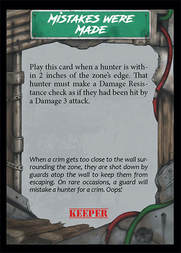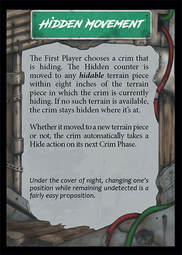
Urban Manhunt is a miniatures game through and through. However, when creating the game system, I decided to add an element of card gaming into the mix. The reason was simple: to create an environment in which the players feel as if anything can happen. This is the primary reason the Event Deck exists.
The secondary reason involves the rules of the sport itself. You see, the players' hunters aren't allowed to attack each other directly, which could have fostered a sense of seclusion and lack of interaction between the players. I didn't want that. I needed to develop a way for the players to affect the hunters controlled by their opponents. Event Cards gave me the means to accomplish that. Take, for example, 'Mistakes Were Made'. When played, a hunter straying too close to the edge of the zone will be attacked by one of the guards, who has mistaken them for a crim trying to escape. Oops!
The Event Deck is placed within reach of all the players. At certain times throughout the game, players will be instructed to draw a card from it. If the card says 'Keeper', the player who drew it places it in their hand for use later on. Otherwise, the effect on the card is carried out immediately and then discarded (unless it also says 'Remains in Play', in which case the card's effects carry on).
The secondary reason involves the rules of the sport itself. You see, the players' hunters aren't allowed to attack each other directly, which could have fostered a sense of seclusion and lack of interaction between the players. I didn't want that. I needed to develop a way for the players to affect the hunters controlled by their opponents. Event Cards gave me the means to accomplish that. Take, for example, 'Mistakes Were Made'. When played, a hunter straying too close to the edge of the zone will be attacked by one of the guards, who has mistaken them for a crim trying to escape. Oops!
The Event Deck is placed within reach of all the players. At certain times throughout the game, players will be instructed to draw a card from it. If the card says 'Keeper', the player who drew it places it in their hand for use later on. Otherwise, the effect on the card is carried out immediately and then discarded (unless it also says 'Remains in Play', in which case the card's effects carry on).

So, how are Event Cards drawn? There are three main sources:
1) Control Cards: At the beginning of each turn, a Control Card is flipped over by the current First Player. Each Control Card has a lot of information on it, but that's not pertinent to this installment. What is important is that the card tells whether or not they draw Event Cards.
2) Rolling 10s: When a player makes a check, one of the d10s is always the Impact Die. It should look different than the other dice rolled. If it rolls a 10, the player has several benefits they can choose from. One of those benefits is the ability to draw an Event Card.
3) Effects: Various effects from hunter special rules or other cards can prompt the drawing of Event Cards.
One might worry that Event Cards will dominate the game, but such fears will prove to be for naught. While they certainly do impact the game, strategy, hunter stats and die rolls remain the most impactful elements. The balance is kept in check by two main factors. First, the number of Event Cards that come into play is fairly limited. That is, players aren't throwing 'Keeper' cards at each other constantly throughout any given turn. Second, many of the card effects are extremely situational. 'Hidden Movement' is a good example of this. If it hits the table and there aren't any Hidden crims in the zone, the card does nothing.
In the end, our playtesters have repeatedly stated that they enjoy the unpredictability Event Cards bring to the table, as well as the additional layer of strategy they introduce. The rulebook will include 60 Event Cards that can be photocopied and cut out and will be available in PDF form for easy print. For those inclined to do so, you will also be able to purchase print-on-demand Event Cards from DriveThru Cards.
1) Control Cards: At the beginning of each turn, a Control Card is flipped over by the current First Player. Each Control Card has a lot of information on it, but that's not pertinent to this installment. What is important is that the card tells whether or not they draw Event Cards.
2) Rolling 10s: When a player makes a check, one of the d10s is always the Impact Die. It should look different than the other dice rolled. If it rolls a 10, the player has several benefits they can choose from. One of those benefits is the ability to draw an Event Card.
3) Effects: Various effects from hunter special rules or other cards can prompt the drawing of Event Cards.
One might worry that Event Cards will dominate the game, but such fears will prove to be for naught. While they certainly do impact the game, strategy, hunter stats and die rolls remain the most impactful elements. The balance is kept in check by two main factors. First, the number of Event Cards that come into play is fairly limited. That is, players aren't throwing 'Keeper' cards at each other constantly throughout any given turn. Second, many of the card effects are extremely situational. 'Hidden Movement' is a good example of this. If it hits the table and there aren't any Hidden crims in the zone, the card does nothing.
In the end, our playtesters have repeatedly stated that they enjoy the unpredictability Event Cards bring to the table, as well as the additional layer of strategy they introduce. The rulebook will include 60 Event Cards that can be photocopied and cut out and will be available in PDF form for easy print. For those inclined to do so, you will also be able to purchase print-on-demand Event Cards from DriveThru Cards.
 RSS Feed
RSS Feed
